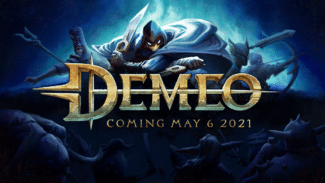Is Resolution Games’ most ambitious VR title yet its best? Find out in our Demeo review!
Demeo is one of those times it works. Y’know, it; the whole promise of leapfrogging the miles between friends and family and experiencing a genuine social connection in virtual space via the magic of VR. Resolution Games has always been good at that but, here? The studio nails it. So much so, in fact, it elevates what is otherwise a really rather fun tabletop RPG into something special. Significant, even.
Over the past week of playing Demeo — sometimes with people across the Atlantic, sometimes even further — I feel like I’ve done something I haven’t done a lot over the past year – see my friends. More so than when I call them over webcam and, in some senses, even more so than a socially distanced face-to-face meetup at opposite ends of a freezing park bench. It’s been proper, care-free quality time, a type I haven’t enjoyed in many other VR apps and a type that’s been sorely missing from all our lives of late. That doesn’t just speak to the strength of the game’s core foundations but also the impressive polish of its social VR elements.
Up to four players can tackle Demeo’s randomized run of three dungeon levels in games that can last anywhere from a few minutes for the careless to approaching three hours or more. Each of you hovers above the gameboard as a customizable avatar situated in a dingy basement that doubles as a time capsule for ’80s D&D fanatics and those that remember huddling around a TV to play Gauntlet (one of Demeo’s more direct influences). The game’s controls have been meticulously refined to make movement, scaling and interaction feel seamless – you grab the air to pull yourself through the environment, point and pull the trigger to pick up cards and character pieces and move your hands back and forth to resize yourself from human scale right down to the point you can fit into one of the dungeon’s uncomfortably tight corridors. As you scale down, your avatar shrinks with you.
The combination of intuitive user experience and presence is as potent as you’ll find in VR; there’s very little to Demeo that’s fiddly or frustrating. Something as simple as a flick of a dice invites anxious anticipation as necks crane to watch it roll across the board, success followed with virtual dancing and rare misses met with visible commiserating. Gone are the awkward blemishes of navigating large virtual environments or wrestling with a restrictive play space; Demeo simply feels like you’ve gathered around a table with friends, and there’s real power in it.
It helps, of course, that the nuts and bolts of the game form a moreish strategy RPG treat – instantaneous to pick up but swiftly punishing any temporary lapse in judgment. If anything you’d compare it more to XCOM than you would classic D&D; each player has two action points per turn that can be spent on a combination of moving, attacking or utilizing specials cards. These show up when you flick your palm upward and offer anything from healing to area-of-effect attacks and temporary invulnerability. Classes, meanwhile, have special abilities like an archer that can attack from afar, or a warrior with replenishable armor that serves them well on the frontlines.
To the initiated, this is all fairly routine stuff and, taken on its own, seasoned dungeon raiders may find Demeo too simplistic. It’s light on confusing intricacies like long-lasting status ailments or cover systems and instead heavy on overwhelming odds. These elements are there in some small degree, but never weigh too heavily on your tactics. Instead, it’s pretty common to use a special attack to streamline a small scrap only to round a corner and find the six or seven enemies you really should have been saving it for. And the enemies really do come thick and fast. Groups of five or six huddle around key points, rat nests have high health and spring multiple rodents if they’re not eliminated quickly, while spider eggs hatch upon attack and some unwelcome monsters even teleport right into the heat of battle from afar.
Frustrating as that may sound — and it sometimes is — the threat of what’s hidden in the shadows is what gives any game of Demeo consistent intensity. Anything but the most cautious of strategies and your two-plus hour run will suddenly turn to disaster. Then it’s back to the start.
Cruel, perhaps, but death is an important part of Demeo. Victory is meant to be rare; the payoff of committed, calculated play and understanding of the game’s flow. It provides a genuine sense of accomplishment. And Demeo does give you the tools to overcome almost any situation with the right approach. Each character class brings meaningful variety, and you can have multiples of the same character too. No one class feels particularly overpowered and they all have drawbacks – the warrior is light on ranged options and the mage isn’t able to deliver heavy damage with his base attacks, for example. A team of archers might sound like a safe bet with the right play, but what happens when you round a corner to find a gang of giant spiders and elementals just a few tiles away?
There’s a flurry of possibilities that makes discussing strategies and routes endlessly engaging. A Tilt Brush-style system lets you draw lines through the maze to help direct plans, and maps are dotted with markers that serve as points of interest. One will be the exit you need to escape (though the key will be held by an enemy in another location), while others serve as chests holding more cards and healing fountains.
All of this comes together in a game of collaborative risk-taking that eats up the hours. I’ve had games of Demeo fall to ruin in late stages after pain-staking effort and felt ready and raring to up and go again the second I get back to the menu. It’s simple, yes, maybe even a little unbalanced at times (I’ve found two-player matches to be more of a struggle than games with a party of three or four), but incredibly replayable when you have a group of similarly enthusiastic dungeon raiders at your side.
Even if you can lose hours in its recycled dungeons, though, it’s true that the game is a little light on content right now. But Resolution is committed to free DLC including the arrival of a second set of levels this summer and what’s there hasn’t grown stale for me yet. The team is also going to add in a mid-game save option which, no, isn’t there right now and, yes, is pretty troubling when games go extra innings. I also suspect some players will want to see more persistence out of it; even if three or four hours is game enough for one sitting, once you’re back to the menu it’s all a fresh start with only a pile of cosmetics to show for your efforts. The ability to string together games into a long-lasting campaign would be very welcome.
There is a single-player Skirmish mode, too, in which you can control three of the game’s heroes yourself. Again, the strength of Demeo’s systems is more than enough for an entertaining time but it’s undeniably at its best in multiplayer, especially without that progression system.
Demeo Review – Final Impressions
Demeo is not a perfect tabletop RPG. Its turn-based combat isn’t especially deep and its difficulty stems from brute force. But it is instantly graspable and endlessly rewarding even when the odds are stacked against you. More importantly, though, it’s a near-peerless social VR experience, polished to such a degree that it transforms the kinks of its systems into enjoyable, suspenseful quirks. Facing its brutish hordes with friends at your side is a thrilling, collaborative endurance test; defeat is met with entertained cries of anguish while victory — rare as that may be — is celebrated with the sort of group-wide elation you might have been missing in this tough past year. Not built for parties of one, then, but if you have a group of three or four ready to raid, Demeo is one of VR’s best.
For more on how we arrived at this score, read our review guidelines. What did you make of our Demeo review? Let us know in the comments below!








